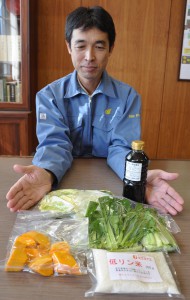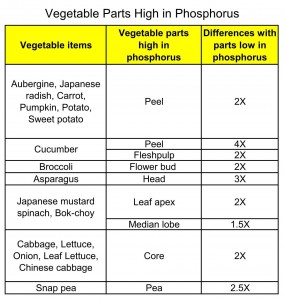Chikako Sakamoto
 As part of its efforts to provide food products fit for people with health problems, Mie Prefecture Agricultural Research Institute has developed low-phosphorus rice and vegetables for dialysis patients who need to restrain phosphorus intake.
As part of its efforts to provide food products fit for people with health problems, Mie Prefecture Agricultural Research Institute has developed low-phosphorus rice and vegetables for dialysis patients who need to restrain phosphorus intake.
The institute is working jointly with two hospitals, a vegetable processing firm and a rice milling firm to evaluate the effects of eating food products with reduced phosphorus content.
Phosphorus which is found in almost every food, is an essential nutrient needed for proper cell functioning, regulation of calcium, strong bones and teeth. But consuming too much of it weakens bones and increases risk of heart attack.
Dialysis patients with chronic kidney disease, amounting to some 300,000 nationwide, need to take medicines to help them remove phosphorus from their bodies. Controlling phosphorus is also necessary to prevent osteoporosis and lifestyle-related diseases from getting worse.
“The market for low-phosphorus foods is huge and it has a potential to grow in the future,” says an institute official Masayuki Hara. “We want to differentiate the products from others as something which are available only in Mie.”
The institute, which has been examining the amount of nutrient content in vegetables, began a survey on phosphorus content in rice and 30 vegetables in 2010 and completed it this year.
They found out that rice, whose usual polishing ratio is 90 percent, contains 100mg of phosphorus per 100g, but the amount of phosphorus is reduced by half if the ratio is 83 percent. They also learned that the amount of phosphorus varies according to different parts of vegetables such as skin and core, with difference of as much as four times at the most.
 Based on the results of the survey, the institute created a “low-phosphorus food package” containing 83-percent polished rice and pre-cut vegetables whose parts with high phosphorus content are removed. The packages are produced by a rice miller in Tsu, Mie Pref. and a vegetable processing firm in Matsusaka, Mie.
Based on the results of the survey, the institute created a “low-phosphorus food package” containing 83-percent polished rice and pre-cut vegetables whose parts with high phosphorus content are removed. The packages are produced by a rice miller in Tsu, Mie Pref. and a vegetable processing firm in Matsusaka, Mie.
The packages are experimentally distributed to 30 dialysis patients to be used in their meals. Some 210g of rice per day is delivered to their homes, and 200g of vegetables per day is given to them when they come to hospitals for dialysis. The institute assesses phosphorus levels in their blood.
Hideyuki Takeuchi, head of Takeuchi Hospital in Tsu which supports the project, said if patients can reduce phosphorus intake by using the package, they can reduce the amount of medicines they take, which leads to reduction of physical and financial burdens. They can continue taking the products because they taste good, Takeuchi added.
The institute also plans to develop ready-to-eat dishes using low-phosphorus products to support efforts to maintain health.
(Dec. 1, 2013)

